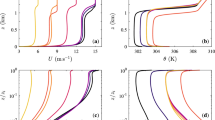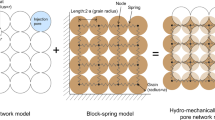Abstract
Solute plume subjected to field scale hydraulic conductivity heterogeneity shows a large dispersion/macrodispersion, which is the manifestation of existing fields scale heterogeneity on the solute plume. On the other hand, due to the scarcity of hydraulic conductivity measurements at field scale, hydraulic conductivity heterogeneity can only be defined statistically, which makes the hydraulic conductivity a random variable/function. Random hydraulic conductivity as a parameter in flow equation makes the pore flow velocity also random and the ground water solute transport equation is a stochastic differential equation now. In this study, the ensemble average of stochastic ground water solute transport equation is taken by the cumulant expansion method in order to upscale the laboratory scale transport equation to field scale by assuming pore flow velocity is a non stationary, non divergence-free and unsteady random function of space and time. Besides the stochastic explanation of macrodispersion and the velocity correction term obtained by Kavvas and Karakas (J Hydrol 179:321–351, 1996) before a new velocity correction term, which is a function of mean pore flow velocity divergence, is obtained in this study due to strict second order cumulant expansion (without omitting any term after the expansion) performed. The significance of the new velocity correction term is investigated on a one dimensional transport problem driven by a density dependent flow field.

Similar content being viewed by others
References
Bear J (1979) Hydraulics of groundwater. McGraw-Hill, New York
Bedient BB, Rifai HS, Newell CJ (1994) Ground water contamination transport and remediation. Prentice-Hall, New Jersey
Dagan G (1982) Stochastic modelling of groundwater flow by unconditional and conditional probabilities 2. Solute Transp Water Resour Res 18:835–848
Dagan G (1984) Solute transport in heterogeneous porous formations. J Fluid Mech 145:151–177
Dagan G (1986) Statistical theory of groundwater flow and transport: pore to laboratory, laboratory to formation, and formation to regional scale. Water Resour Res 22(9):120S–134S
Dagan G (1987) Theory of solute transport by groundwater. Ann Rev Fluid Mech 19:183–215
Dagan G, Neuman SP (1991) Nonasymptotic behavior of a common eulerian approximation for transport in random velocity fields. Water Resour Res 27(12):3249–3256
Fetter CW (1993) Contaminant hydrology. Prentice Hall, New York
Fischer HB, List EJ, Koh RC, Imberger J, Brooks NH (1979) Mixing in Inland and coastal waters. Academic, NewYork
Gelhar LW (1986) Stochastic subsurface hydrology from theory to applications. Water Resour Res 22(9):135S–145S
Grobner W, Knapp H (1967) Contribution to the method of lie series. Bibliographisches Intstitute, Mannheim
Kabala ZJ, Sposito G (1991) A stochastic model of reactive solute transport with time-varying velocity in a heterogeneous aquifer. Water Resour Res 27(3):341–350
Kabala ZJ, Sposito G (1998) Technical comment on: “On the stochastic theory of solute transport by unsteady and steady groundwater flow in heterogeneous aquifers”. by M. L. Kavvas and A. Karakas (Journal of Hydrology vol 179 (1996) 321–351), Journal of Hydrology 207:136–138
van Kampen NG (1981) Stochastic processes in physics and chemistry. Elsevier Science Publishing Company Inc, New York
Kavvas ML (1999) On the ensemble average conservation equations for solute transport in heterogeneous aquifers. In: Proceedings of the international conference on water, environment, ecology, socio-economics and health engineering, October 18–21, Seoul, Korea
Kavvas ML (2001) General conservation equation for solute transport in heterogeneous porous media. J Hydrol Eng 6(4):341–350
Kavvas ML, Karakas A (1996) On the stochastic theory of solute transport by unsteady and steady groundwater flow in heterogeneous aquifers. J Hydrol 179:321–351
Kubo R (1962) Generalized cumulant expansion method. J Phys Soc Jpn 17(7):1100–1120
Mazzia A, Putti M (2005) High order godunov mixed methods on tetrahedral meshes for density driven flow simulations in porous media. J Comput Phys 208:154–174
Shvidler MI (1993) Correlation model of transport in random fields. Water Resour Res 29(9):3189–3199
Sposito G, Barry DA (1987) On the Dagan model of solute transport in groundwater: foundational aspects. Water Resour Res 23(10):1867–1875
Wood BD, Kavvas ML (1999a) Ensemble-averaged equations for reactive transport in porous media under unsteady flow conditions. Water Resour Res 35(7):2053–2068
Wood BD, Kavvas ML (1999b) Stochastic solute transport under unsteady flow conditions: comparison of theory, Monte Carlo, and field data. Water Resour Res 35(7):2069–2084
Author information
Authors and Affiliations
Corresponding author
Additional information
An erratum to this article is available at http://dx.doi.org/10.1007/s00477-007-0122-5.
Appendices
Appendix A
The solution to Eq. 9 with the help of ordered exponential can be written as
Here a stands for the non random/sure initial condition for the variable H. If we take ensemble average of the Eq. 28 we obtain
Here we have followed van Kampen (1981) and used the commutativity of ensemble averaging operator with ordering. If we follow van Kampen (1981) again and treat the operators inside the ordering as if they commute we can write
which is also given by Kubo (1962). The symbol ≪ ≫ here stands for the cumulant operator. If we extend the second exponential inside and perform partial ordering we obtain
Equation 31 at the second order is
Note that the cumulant operation is equal to the ensemble averaging when there is one argument inside the cumulant operator. Also it is important to recognize that the terms omitted are high order cumulants to reach the Eq. 32 and they are smaller than the low order cumulants kept in Eq. 32. If we write the differential equation for 〈H 〉 by using Eq. 32 we obtain Eq. 11.
Appendix B
Using Eqs. 7 and 10 in Eq. 11 we obtain
By using the following equality given by van Kampen (1981)
we can obtain the following equalities
Using Eqs. 35 and 36 in Eq. 33 and performing left multiplication by the time ordered exponential of A 0(t) we obtain the Eq. 12.
Appendix C
Although the following equalities, which are known as disentangling theorems, can be driven mathematically, we will just copy them from Wood and Kavvas (1999a) as
If we separate our A 0(t) operator as
and use then in Eqs. 37 and 38 we obtain
By using the following Lie operator properties below given by Grobner and Knapp (1967)
where
If we write the simplified ordered exponentials of A 0(t) (Eqs. 41, 42) in Eq. 13 our ensemble averaged equation becomes
where
If we apply the Lie operator properties given above in Eq. 43 again, the Eq. 43 becomes
where
By writing α A 1(t) operator in Eq. 44 we obtain
where
Note that ordered exponentials in Eq. 44 became regular exponentials since they contain only functions in them. After applying the differential operators in Eq. 45, we obtain the explicit ensemble averaged/field scale/up scaled solute transport equation as given in Eq. 14.
Rights and permissions
About this article
Cite this article
Sirin, H. The effect of non divergence-free velocity fields on field scale ground water solute transport. Stoch Environ Res Ris Assess 20, 381–390 (2006). https://doi.org/10.1007/s00477-006-0031-z
Published:
Issue Date:
DOI: https://doi.org/10.1007/s00477-006-0031-z




